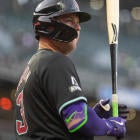
So much Fantasy Baseball content these days is geared toward deeper end of the pool, what with 15-team Rotisserie leagues being the format of choice for those who consider themselves experts.
That format has its own unique economy and idiosyncrasies, as every format does. There's the fevered pursuit of anyone who comes within arm's length of the closer role, the emptying out of FAB accounts for every quasi-prospect who gets the call, and the creeping realization that there isn't enough pitching to go around. It's all too familiar to those of us who take part in that format, and if that includes you, great. I'm not looking to harsh anyone's buzz. I am, however, pointing out that as a percentage of the Fantasy Baseball audience, you're being overserved.
Never is the divide between the expert leagues and the plebeian leagues clearer than when I get a question in my inbox -- like, any question. Here's one example:
But scott my leaguemates are dropping top 150 picks scott how do i hoard the pitching prospects and capitalize on my leagues mistake scott help
— nan (@nanAtable41) April 5, 2024
And another:
Would you drop Michael king for blanco, Jared jones, or houck? Roto league
— Luis (@LAMichel92) April 2, 2024
One more for good measure:
Who do I even drop at this point. Is he better than anybody I have rostered for my 12 team ? I doubt it pic.twitter.com/klEQVF5Vfj
— Lam₿ardi 🌋⚡️ ⒀%'er 58K (@ELITEHODL) April 2, 2024
Having to drop Michael King or some other top-150 pick? No way to make room for Ronel Blanco? That's a whole different way of playing Fantasy Baseball. And according to the research I've done, it's the more common way -- like, exponentially so.
It makes me wonder if the outsized focus on deep leagues has obscured many of the shallow league insights that we once took for granted. If you take something granted for long enough, people just stop hearing about it, and it becomes fresh and new again.
We do a pretty good job here at CBS Sports of serving the wider audience, namely by using actual roster percentages to inform our add/drop and start/sit advice. But add/drop and start/sit advice can be applied to all format types. What's missing for the shallow league audience is any discussion of the complications unique to their format. It's not the fevered pursuit of saves or the looming catastrophe at starting pitcher. It's ... something else.
Specifically, I want to focus on the concept of roster surplus. What do you do when there's a player on the waiver who you want to add -- who needs to be added, according to people like me -- but you don't have anyone to drop? It's easy to say "well, drop your worst player," but what if your worst player is the one who I said you needed to pick up yesterday? You're rightfully trying to corral every breakout possibility, but there simply isn't enough space.
That's where the infamous 2-for-1 trade comes -- or as I prefer to call it, consolidating talent. When you have no one to drop, find someone who does and offer him two of your too-good-to-drop players for one even better player.
But why? What's the rationale? For one thing, it sidesteps the no-win scenario of either discarding or forgoing a player who should be rostered. Instead, you're converting a should-be-rostered player into an even better asset and then going back to the well for more. It's true that you're giving up the two and getting back only the one, which may seem like a loss on balance, but the better way to think of is that you're also acquiring the waiver wire pickup in the deal. That was the entire impetus, after all. It's just that this way use your surplus wisely (by cashing in for an upgrade elsewhere) rather than squandering it (by simply dropping a player).
Another way to think of it is that there's value in the open roster spot itself. It's part of what you're acquiring in the 2-for-1 deal. I think everyone recognizes this intuitively, which is why you can't expect to pull off what a third-party observer would consider to be a dead-even swap, but it's not as clear just how valuable the open spot is. I'd consider it vitally important in leagues so shallow that the waiver wire is basically a wellspring of new talent.

Fantasy Baseball Today Newsletter
Your Cheat Code To Fantasy Baseball
You're destined to gain an edge over your friends with advice from the award-winning FBT crew.
Thanks for signing up!
Keep an eye on your inbox.
Sorry!
There was an error processing your subscription.
Therein lies the two keys to making this approach work:
- The league has to be shallow enough that waiver wire quality is consistently high. Basically, the player you're picking up has to be as good as one of the two you're trading away -- less proven, perhaps, but realistically capable of comparable, if not better, production. This time of year, when the waiver wire has been picked over less and the fakeouts haven't weeded themselves out yet, that's likely to be the case in leagues where fewer than 300 players are rostered. The standard Head-to-Head points league on CBS has only 252 rostered players (12 teams, 21-man rosters), and it's well suited for this approach. If you play in a 10-team league, that's of course even more true for you.
- You have to be willing to "lose" the trade, in an objective sense. The other person isn't going to take the second player in a 2-for-1 trade unless the offer is too good to pass up. You could accomplish this by catering to his needs, perhaps -- i.e. finding his weakest position and offering him an upgrade there (in addition to a second player) -- but his needs won't always match up with your surplus. The more reliable way, then, is to "overpay" for the one player you're getting in return. Maybe you think Randy Arozarena and Jose Berrios is a fair enough offer Yordan Alvarez -- and maybe it is -- but packaging Michael Harris with Berrios will come closer to having the deal accepted. It may seem like too much on paper, but you've upgraded in the outfield, from Harris to Alvarez, and since it's all to make way for Jack Flaherty off the waiver wire, will you miss having Berrios?
Maybe the Flaherty pickup won't be the one that pans out, but in a league so shallow, you can trust that there will always be a next man up, that the free roster spot will always serve a purpose. And if you can incrementally improve the rest of your roster every time you need to free up a roster spot, you could consolidate your way into being a true juggernaut. That's how I first found success in Fantasy Baseball, and the same is true for many others who now count themselves among the experts. It's why I describe the 2-for-1 trade as "infamous" and this whole approach as "taken for granted." But again, if everyone stops talking about it, then eventually it's forgotten.
Case in point, here's how the author of the first tweet mentioned in this article responded to my much quicker explanation on Twitter:
This makes so much sense, just never connected the dots. Thank you bud
— nan (@nanAtable41) April 5, 2024
Consider the dots connected.






















